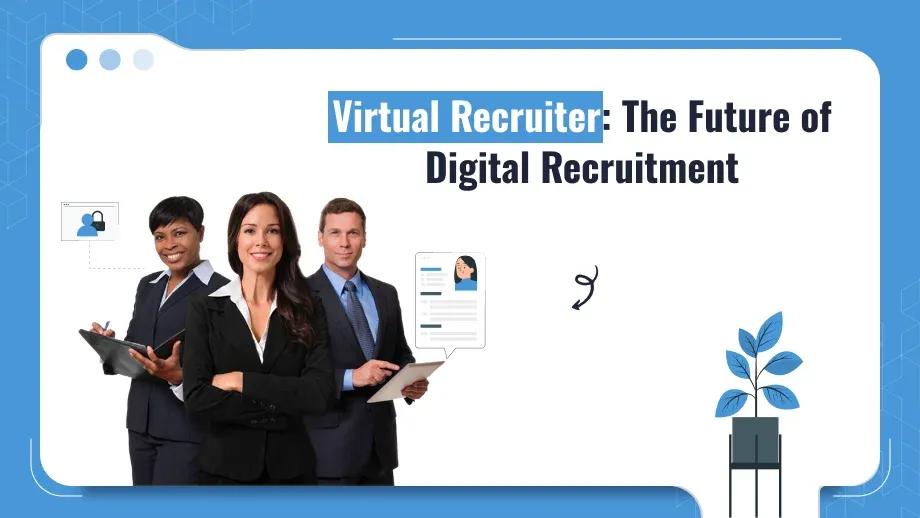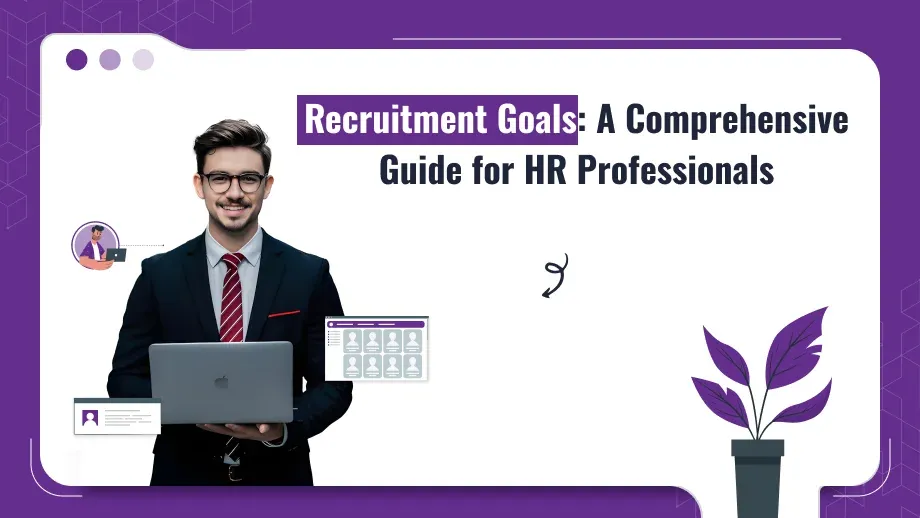
Recruitment has made significant strides in today’s fast-paced technology-driven world. Traditional methods gradually give way to sophisticated, modern systems to stay ahead of the technological time. One of the most significant innovations in this field is the online recruitment system. With virtual recruiter technologies and technology, firms can now access a wider talent pool, simplify the process of hiring, and become more effective than they ever were before.
What is a Virtual Recruiter?
Virtual recruiters are artificial intelligence or human software that performs recruiting from a distance. They use software to streamline and control different aspects of the recruitment process from candidate selection to scheduling interview dates. Unlike traditional job roles that typically need face-to-face interaction with the candidate, a recruiter conducts everything on the Internet, which makes the process of recruiting quicker and more efficient.
Virtual recruiter use tools like Applicant Tracking Systems (ATS) and other recruitment software to filter resumes, screen candidates and manage communication. With the help of digital recruitment, it can cut down on manual tasks and boost the accuracy of matching candidates.
Benefits of Virtual Recruiting
Wider Talent Pool:
Virtual recruiters do not get restricted by location since they remotely work from anywhere in the world. This allows employers to recruit talent globally to identify the best candidates globally. This is particularly beneficial for businesses that are not located near or looking for niche expertise in high market competition.
Cost-Effective:
When they go virtual businesses can cut expenses associated with hiring in-house including offices, travel costs for interviewing, and paperwork. Virtual recruiters are less expensive in overhead as they’re either outsourcing or automated, and there is no requirement for huge internal teams.
Speed and Efficiency:
A single of the most significant benefits of using virtual recruitment is its speed. Automation in the process of virtual recruitment means quicker screening of resumes, faster contact with applicants, and a shorter time to hire. This can provide companies with an edge when it comes to finding top talent ahead of competitors.
Improved Candidate Experience:
The recruiter can communicate with applicants 24/7 using automation applications like chatbots, AI, and interviewing systems. This means speedier responses and a smoother recruitment process that ultimately enhances candidates’ experience at the business.
Scalability:
The recruiter can increase or decrease the size of their staff based on the hiring requirements of a business. Whether a firm is rapidly growing or just requires only a handful of positions, online recruiters can adapt to the demands, ensuring that the resources are effectively allocated.
Virtual Recruiting Ideas for Modern Companies
Leverage Social Media for Recruitment:
The virtual recruiter can reach potential candidates and post job opportunities using channels such as LinkedIn, Twitter, and even Instagram. Targeted advertisement and content marketing can be used to attract candidates who are not actively looking for a job but may be interested in exploring a possibility.
Host Virtual Career Fairs:
Numerous companies are holding virtual career fairs for a better way to meet a bigger selection of potential candidates. These events enable job seekers to communicate with recruiters on the spot to submit resumes and hold preliminary interviews at the convenience of their own homes.
Video Interviewing:
Virtual recruiters may make use of video interviewing platforms to conduct preliminary interviews with applicants. This saves time for both the candidate and the applicant and permits companies to review candidates before inviting the candidates for an in-person interview, or last rounds.
Data-Driven Recruiting:
One of the greatest weapons it might have is data, as it can employ recruitment statistics and analytics tools to track what works and adjust their technique over time to make hiring more effective.
Key Tools and Technologies for Virtual Recruiting
Applicant Tracking Systems:
An ATS is an absolute necessity in every recruitment process either in-house or via a virtual. It allows the recruiter to manage resumes, monitor candidates, and plan interviews on one platform. ATS tools simplify the process of hiring so that the recruiter on the internet can concentrate on the process of sourcing talent that is efficient.
Video Interview Platforms:
A primary technique for virtual hiring is software for video interviews. Platforms like Zoom or other tools for recruitment such as HireVue permit recruiters to conduct remote interviews, evaluate potential candidates’ communication capabilities, and evaluate potential candidates without having to attend meetings in person. This adds versatility and speeds up the process of hiring.
AI-Powered Screening Tools:
AI plays an important part in the virtual recruitment process because it automates the beginning phases of recruitment. AI screening tools sort through huge numbers of resumes and then find the top candidates for descriptions of jobs. This reduces the chance of bias and helps recruiters concentrate on the best candidates.
Recruitment Software for Candidate Engagement:
Tools for recruitment such as chatbots permit chatbots to communicate with potential candidates 24 hours a day. These systems provide answers to questions, arrange interviews, and inform candidates during the process of hiring in real time.
HRMS Payroll Software Integration:
Virtual recruiter often require their systems for recruitment to function smoothly with HRMS payroll software, particularly in larger companies or in regions such as India where compliance with the payroll system is required. These integrations make it easier to transfer from employee to candidate while ensuring that onboarding and payroll processes are in sync.
Is your current recruitment strategy slowing you down?
Discover the power of virtual recruiting and streamline your hiring process today. Connect with top talent faster and more efficiently.
How Virtual Recruiters Speed up Recruitment
1. Automated Resume Screening:
Automation is an enormous aid in the speed at which an online recruiter can handle a lot of resumes. For example, applicant tracking systems (ATS) will automatically sort out resumes according to predetermined requirements like skills such as qualifications, experience, or even education. This reduces the amount of time HR personnel have to spend reviewing each application manually. As a result, employers get speedier time-to-hire, which is vital in highly competitive markets in which top talent is swiftly snatched up.
2. Video Interviewing:
Another benefit is the video interviewing platforms. Online recruiters do not have to wait around for applicants and interviewers to be in the same room simultaneously. They can conduct video-based interviews in which the candidates can record their answers to questions to be set. This flexibility permits hiring managers to look over the interviews whenever they want as well as accelerate the hiring decision-making process.
3. Automated Communication:
Virtual recruiter utilize automated messages to inform candidates all through the application course. Whether it’s scheduling reminders to interview and providing feedback, or even giving applicants an update regarding their progress in submitting applications These systems help keep them engaged and stop the process from slowing down due to delays in messages.
4. 24/7 Availability:
Since the process of virtual recruiting is based on technology, this makes the hiring process to be available 24/7. Automated systems such as Recruiting Chat as well as chatbots manage inquiries from applicants, plan interviews, and provide updates during non-office time. This is extremely beneficial when you are recruiting internationally as time zones could delay the process of hiring.
Virtual Recruiting Challenges and How to Overcome Them
1. Technology Dependence:
Virtual recruitment relies heavily on technology, which may malfunction at times. Issues like slow internet connections, old software, or even a system crash could delay the process of recruiting. To minimize this risk, employers must update their software for recruitment often, conduct frequent tests and put backup systems.
2. Managing Candidate Volume:
A virtual recruiter is capable of attracting applicants from around the world, the amount of applications may be for one to manage. While this is generally a positive issue to face, however, it is difficult to control without appropriate filtering and screening systems. Applicant tracking systems (ATS) and AI-driven applications aid in filtering applicants, allowing recruiters to be able to focus on the top applicants.
3. Impersonal Experience:
Certain candidates might feel that the virtual process is not personal particularly when interactions are limited to automated systems or only one-way interview sessions. To counter this, It must include human interaction wherever feasible, such as personal introductions to interviewers, Q&A sessions, and the virtual tour of offices. These strategies help keep applicants engaged and make sure they enjoy a positive experience through the process of hiring.
Virtual Recruiter in Digital Transformation
1. Aligning Recruitment to Business Strategy:
In today’s highly competitive work environment, online recruiters can help businesses align their recruitment strategies with the business’s overall objectives. Using AI and data-driven insight to analyze the required skills to ensure future growth and align these requirements to the available talent. This makes the virtual recruiting process of recruiting via virtual means more efficient and helps to address shortages before they turn into crucial.
2. Supporting Remote and Hybrid Work:
While remote work continues to increase, the use of virtual hiring is vital for identifying people who are suited to working in hybrid or distributed positions. A virtual recruiter is able to identify those who are suitable for working remotely and confirm that they possess the skills and tools to excel in these settings. This supports companies’ digital transformation through recruiting talent who is flexible and technologically adept.
3. Organizational Flexibility:
Utilizing a virtual recruiter, businesses can increase their recruiting capacity quickly and change with the market for jobs without the necessity of large internal groups. This is crucial for businesses that need to remain competitive in the technological environment. Plus virtual recruiting lets businesses adjust their recruitment in real-time. regardless of whether they require ramping up their hiring in an expansion phase, or to decrease their hiring in an era of change.
Virtual Recruiting Events and Candidate Engagement
A major lesson learned from the blogs of competitors is the significance of recruiting via virtual events. Businesses have been hosting virtual open houses, job fairs as well as educational events to meet prospective candidates. These types of events are beneficial as they enable companies to reach out to talent groups who might not know about their brands. These events can also reduce the requirement for applicants to travel to reach out to a larger talent pool. This can be particularly beneficial when you need international or remote candidates.
Enhancing Candidate Experience During Virtual Recruitment
The biggest recruitment challenge in the use of virtual recruitment is maintaining the positive experience of candidates. Virtual recruitment is often untrustworthy in particular when automated software or one-way interviews are utilized. To mitigate the issue, many companies have begun to incorporate interactivity into their virtual procedures, like interviews, Q&A sessions, and virtual office tours or intros for interviewers before the hiring process. This helps applicants feel more involved and appreciated despite the absence of interaction with a person.
Overcoming Technology and Logistical Challenges
Although technology can be a major enabler in virtual hiring, it could be a challenge. For example, technical problems like slow internet connection or system malfunctions could disrupt interviews and onboarding processes. To counter such issues, businesses are encouraged to prepare backup strategies and thoroughly check their systems before when the actual process of hiring commences. Additionally, making clear the requirements for jobs in announcements will help in managing the number of applications that often pour through due to the elimination of geographic barriers.
Summary
In the digital age, the concept of virtual recruitment is an essential component of the most modern strategy for recruitment. It gives organizations unparalleled speed, flexibility as well as access to talent from all over the world. Virtual recruiters can not only streamline the recruiting process, but they also support technological advancement by automating manual processes to improve the candidate experience, as well as facilitating remote work.





